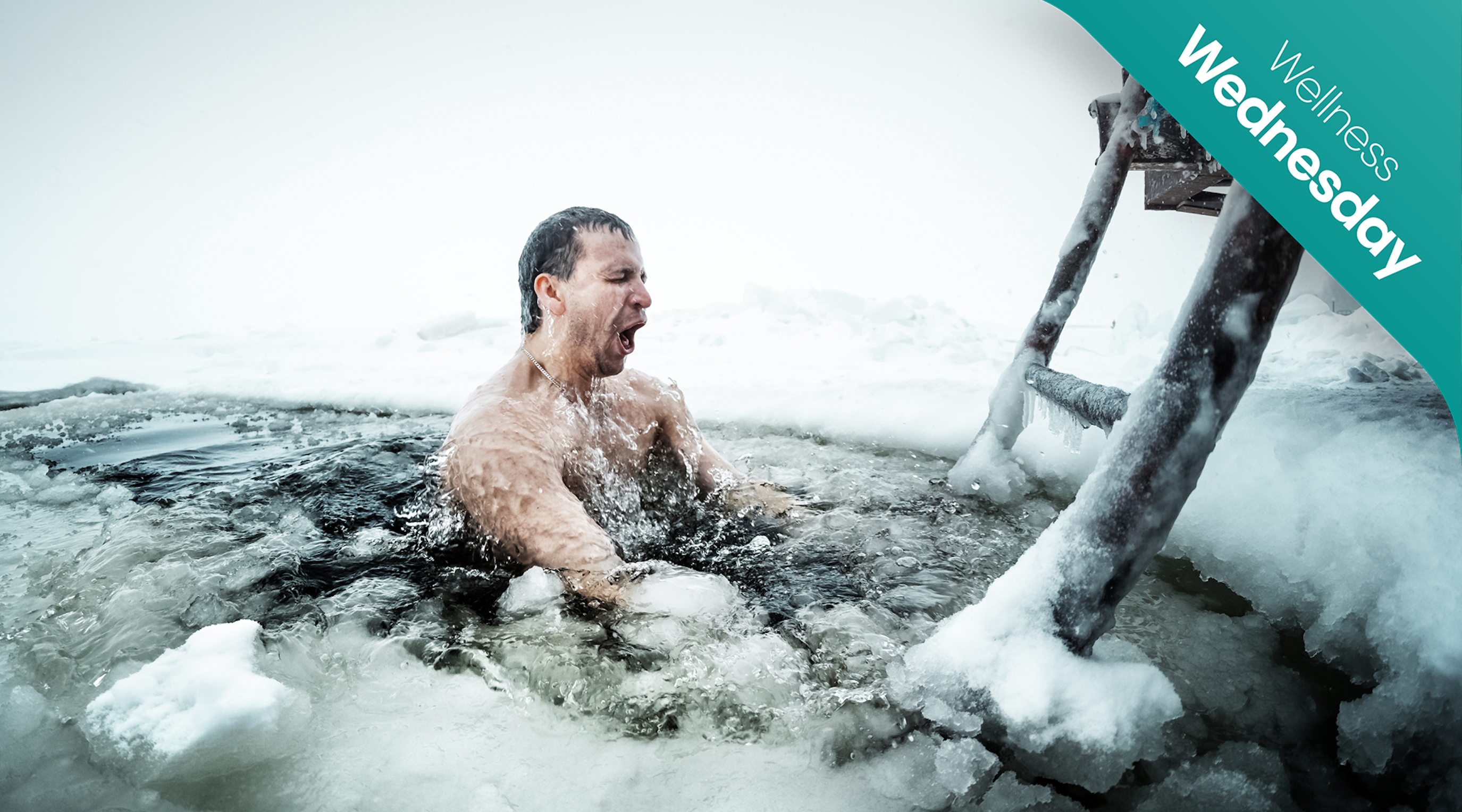The ice plunge: How cold exposure therapy can improve your health
12 min read
Editorial Team
Contents
A new health hack for the New Year
In this week's Wellness Wednesday, we will look at a health and fitness technique that has been taking the internet by storm and is being adopted and recommended by celebrities, influencers, scientists and health coaches.
There is more to this technique than simply being the latest fad or craze when you look into the science. Finding this information on a medical cannabis clinic's website might give you an indication of what this is.
What is cold exposure therapy, and why is it becoming so popular?
Cold exposure therapy is when you expose your body to temperatures below 15 degrees Celsius for several minutes. Cold exposure is sometimes referred to as cryotherapy.
People will immerse themselves in cold water, often with ice, to help lower the temperature of their body tissue and feel reported health benefits, some of which have been studied and backed up by science.
Methods people use for cold exposure therapy are:
- cold water plunge tanks
- cold showers
- ice baths
- outdoor water exposure
Cold exposure therapy is becoming popular because the health benefits sound remarkable, so much so that people in influential positions have been recommending it to their followers on social media.
The technique has long been used for health, but the mechanisms were unknown. Still, the recent gravitation to the trend started when Wim Hoff began uploading videos to YouTube and sharing the information he had learned through his experiments. These have brought it to the mainstream.
He passed on techniques he developed and explained how it had helped him overcome grief when, in 1995, his wife died from suicide and left him with four young children. He found life paralysing.
Wim, a Dutchman nicknamed "The Iceman", used the cold exposure as a way to overcome the psychological trauma of losing his wife. But, in the process, he learned to control his bodily functions, slowing down his heart rate, breathing and blood circulation under extremely cold conditions.
The science of cold exposure is pretty cool
During his career sharing this information with the world, Wim Hoff has set several world records, climbing Mount Kilimanjaro in shorts, running a half marathon in the Arctic Circle - barefoot, and standing wholly submerged to his neck in ice-cold water for 112 minutes.
These incredible achievements have made people consider trying his techniques, which he believes anybody can learn and harness if he can.
These incredible feats of human endurance have also caught the attention of scientists keen to study Win Hoff and the participants of his methods. Researchers started looking into Wim and his claims in 2007. And it was in 2011 when a team of investigators discovered he could control his autonomic nervous system.
In 2014, a study with endotoxin showed participants were able to control their sympathetic nervous system and immune response, which indicates cold exposure may be a way for people with autoimmune disease and potentially pain.
This pain hypothesis was further supported by a 2018 study showing that the Wim Hoff Method activated areas of the brain that play a part in pain. In total, 14 scientific studies have been conducted directly on the Wim Hoff Method, but further studies are looking into thermoexposure and its biological effects.
In essence, the body uses shivering and nonshivering functions to keep the body's internal temperature up. During the process, it has a lot of beneficial side effects that can be taken advantage of.
What are the reported health benefits of cold exposure?
Cold exposure therapy has been reported to have the following health responses:
- Speeds up metabolism
- Reduces inflammation
- Reduces sore muscles
- Speeds up recovery after physical exercise
- Improved sleep quality
- Increased focus
- Improved immune response
- Higher energy levels
- Stress relief
- Higher levels of brown fat/Brown Adipose Tissue (BAT)
- Burns excess white fat/White Adipose Tissue (WAT)
- Increased dopamine
- Increase in endocannabinoid levels
Weight loss
Short exposure to cold temperatures activates brown fat, which helps increase the burning of white fat to help provide the energy needed to stay warm. However, the effect is not the same for everyone.
Brown fat is usually much higher in babies because they cannot shiver; it allows them to burn energy and stay warm. It surprised scientists to find out that cold exposure raised BAT in adults. The discovery has interested international obesity researchers.
Timing cold exposure in the morning showed more benefits for men than women when it came to seeing the effects of burning fat. The same results were seen for women during cold exposure at either end of the day. However, scientists noted that women are more resistant to cold temperatures in the morning.
With obesity being a contributing factor to a wide range of health issues, finding a noninvasive and cost-effective therapy to reduce obesity and other health complaints is exciting.
Immune function
Exposure to 30, 60 and 90 seconds of cold water is linked to the body's ability to fight virus infections. A study in the Netherlands showed that people who showered for one of these times in the morning for 90 days were 29% less likely to call in sick for work than those who showered normally.
Cold exposure treatment in mice with Multiple Sclerosis triggered an energetic trade-off between autoimmunity and thermogenic response. By modulation of immune cells (monocytes), cold exposure improves neuroinflammation.
Mental health
A study examining two groups of women exposed to two types of full-body ice water immersion for extended periods compared to a control group revealed that noradrenaline levels increased 2-3 fold with cold exposure. Cold exposure improves cognitive function, attention, stress reaction, and pain control. It indicates that long-term regular cold exposure therapy can play a role in improved mental health.
Recovery time
Sports athletes are finding cold exposure therapy beneficial to their post-workout and performance recovery routine. It’s something that football and rugby fans might remember seeing in post-match changing room scenes on TV, predating Wim Hoff by some years.
Some athletes believe that ice bath speeds up recovery time; others find that it is more beneficial for endurance. Either way, it is becoming increasingly popular in the sport and fitness arena. By constricting blood vessels, waste products are believed to be flushed through the system like lactic acid from the muscles. It’s suggested that it reduces tissue breakdown and swelling, but studies have not figured out exactly what is behind these claims just yet.
Cold exposure increases endocannabinoid receptor activity
The human nervous system have pain receptors that are controlled by cannabinoid like compounds our body's produce naturally.
The network of receptors carrying out this function is called the Endocannabinoid System. Cannabinoid receptors play an important role in pain response, appetite and energy metabolism and immune functions.
Our bodies produce endocannabinoids and similar compounds to send signals to respond to pain or when the immune system needs to care for something. When people become ill with an autoimmune disease or neurological disorder, it may be due to signalling problems in the endocannabinoid system.
The endocannabinoid system plays a role in energy levels and how and when we burn fat off as energy. Research indicates that the sympathetic nervous system (how you respond to fight or flight) regulateshow the endocannabinoid system controls the function of brown and white fat.
Whilst it's not exactly an increase in endocannabinoids, neurotransmitters that activate cannabinoid receptors do rise two to three fold.
How to try out cold exposure at home
Cold exposure won’t be suitable for everyone. Check with your GP first before you try any of these suggestions and check out the list at the end for health conditions that make it extra risky.
You can try cold exposure therapy at home in a few different ways.
Run a cold bath and put blocks of ice or cubes there to lower the temperature. You might want a thermometer handy to monitor the temperature before entering.
Some people use a dustbin in the garden or on a balcony as it is easier to stand up in and escape. If you are worried about falling over, having someone assist you might be a good idea.
Turn your shower on fully cold and let it run for a few minutes, and it will flow as cold as possible. If this isn't cold enough, the solution might be one of the above options.
You don't have to start as cold as humanly possible.
Many people find it easier to start with just a few seconds at a time and begin at 15 degrees Celcius before lowering it. You don't want to make it too warm; part of the process is to shock the body.
- Keep the water below 15 degrees Celcius (60 F)
- In a shower at home, make it as cold as it can go.
- Go slow: Start with 10 seconds of cold water
- Work up to a minute gradually each time you do it
- Aim to take a cold shower for two to three minutes
- Alternate between hot and cold but end in cold
Cold exposure FAQs
Who should not do a cold plunge?
Cold plunging is generally safe, but if you have heart issues, high blood pressure, or circulation problems, it's best to skip it since sudden cold can stress your heart. Those with asthma or other respiratory conditions might respond poorly to extreme cold. If you have nerve damage, diabetes, or joint issues, the cold could worsen symptoms. Pregnant women and those with compromised immune systems should check with a doctor first.
What's better, sauna or cold plunge?
Both have been proven to offer a range of health benefits, but the choice between one or the other ultimately comes down to personal preference and your individual health goals. Saunas are great for relaxation, detoxification, and improved cardiovascular health, while cold plunges can increase energy, boost immunity, and reduce inflammation.
If you can access both, alternating between the two may provide the best of both worlds. Known as contrast therapy, combines the relaxation and detox benefits of heat with the anti-inflammatory and circulation-boosting effects of cold exposure.
Are cold plunges good for your brain?
Yes, cold plunging has been shown to have a range of positive effects on the brain. The cold temperature causes dopamine levels to shoot up by 250% and noradrenaline by 530%, which can really help lift your mood and ease anxiety and stress.
It also increases blood flow to the brain, boosts the endocannabinoid system, and may stimulate the production of brain-derived neurotrophic factor (BDNF), a protein that helps with neuron growth and repair.
The plunge
Cold exposure therapy is being analysed for its potential to improve your metabolism, immune function, mood, pain control and inflammation.
Through various biological functions, including the endocannabinoid system, the evidence that is emerging for cold exposure therapy suggests it could potentially help regulate autoimmune diseases, maintain good health, prevent illness and speed up recovery from illness and exercise.
Regular exposure to short periods of cold immersion can elevate mood, focus and cognition.
It's easily accessible and relatively cheap to try. It is a non-invasive way of managing your wellbeing or just trying to improve your general health.
To finish, one thing we haven't covered about cold exposure therapy is who it might not be suitable for. It's essential to consult with your healthcare provider before starting cold exposure therapy, especially if you have certain health conditions:
- Heart disease or severe circulatory issues, temperature drops can cause a strong cardiac response
- Cold urticaria (hives), a skin reaction to cold exposure
- Raynaud's syndrome - numbness in your fingers and toes as a reaction to cold temperatures
Share article
Did you like this article?
It is important to seek medical advice before starting any new treatments. The patient advisors at Releaf are available to provide expert advice and support. Alternatively, click here to book a consultation with one of our specialist doctors.
Elevate your wellness with medical cannabis
Get comprehensive care, convenience, and confidence with an all-in-one treatment plan.
Am I eligible?Authors
Editorial Team
Article written by the Releaf Editorial Team, a group of seasoned experts in cannabis healthcare, dedicated to enhancing awareness and accessibility in the field through their wealth of knowledge and experience.
fact checked
Compliance Director
Editorial Policy
All of our articles are written by medical cannabis experts, guided by strict sourcing guidelines, and reference peer-reviewed studies and credible academic research. Our expert clinical team and compliance specialists provide valuable insights to ensure accuracy when required. Learn more in our editorial policy.
Need more help?











